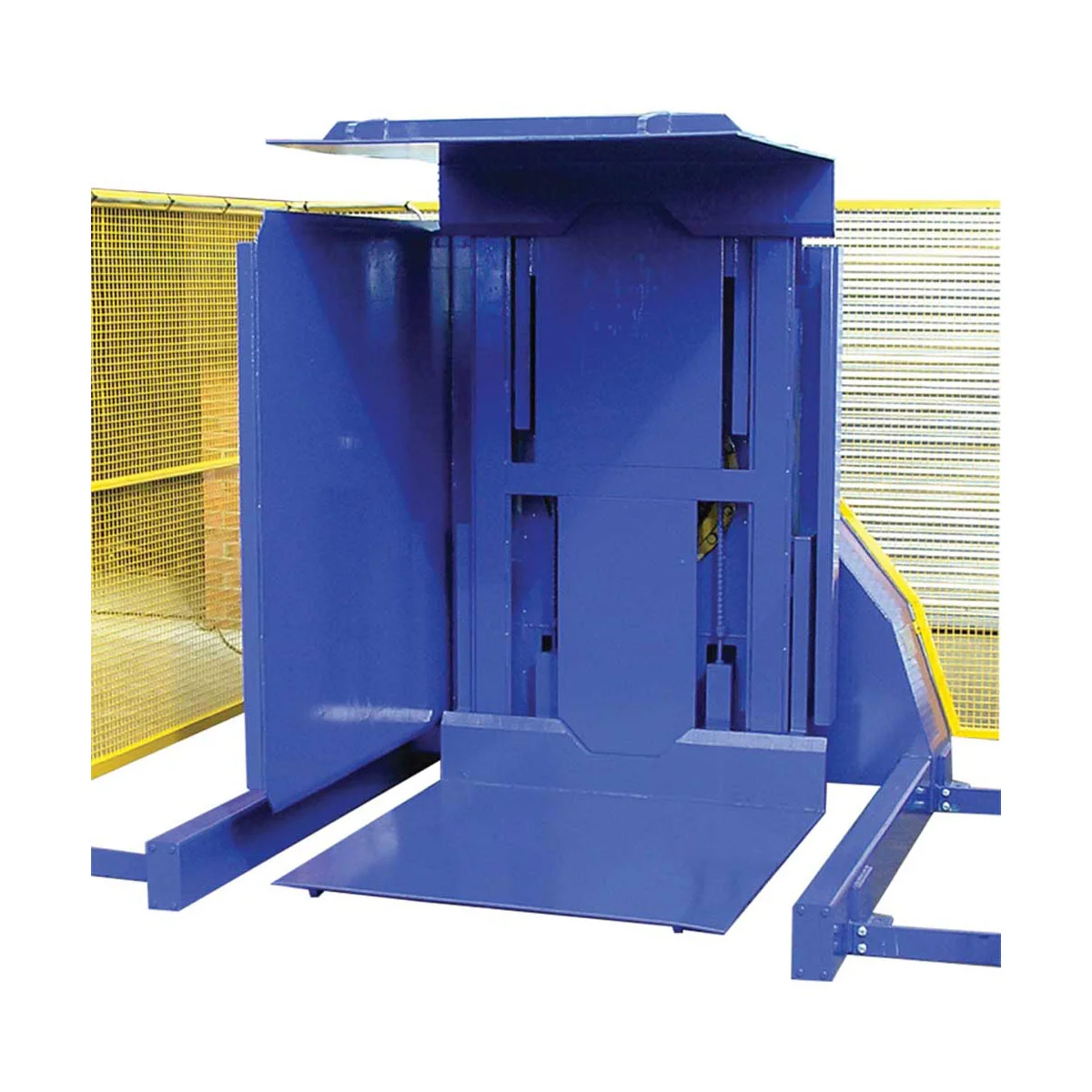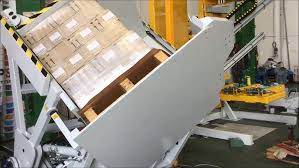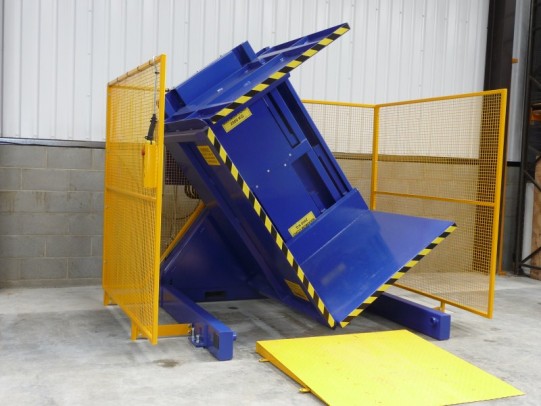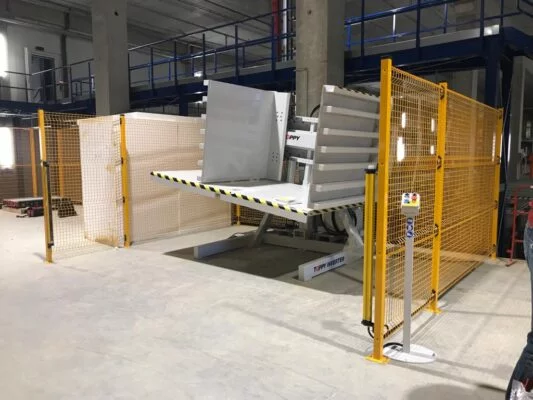Meeting Cost-Competitive Pallet Systems For Logistics Hubs Requirements in Romania with Automated Pallet Exchange
Are you running a logistics hub in a competitive market like Romania? Then you know the pressure is constant. Every day, you're fighting to move goods faster, more safely, and at a lower cost. The manual process of exchanging pallets is a major bottleneck. It's slow, it requires a lot of manpower, and it often leads to damaged products or, even worse, workplace injuries. These issues eat away at your profits and make it incredibly difficult to stay ahead. What if there was a way to solve this? A way to turn one of your biggest operational headaches into a competitive advantage. This is where automated pallet exchange systems come in. They are designed to tackle these exact problems, streamlining your workflow and directly impacting your bottom line.
An automated pallet exchange system meets the cost-competitive requirements for logistics hubs in Romania by directly replacing expensive and inefficient manual labor with a fast, reliable machine. This automation drastically cuts wage-related costs, minimizes product damage during transfers, and accelerates throughput. For hubs dealing with international trade or strict internal hygiene standards, these systems are essential for quickly and safely switching goods between different types of pallets, ensuring seamless integration with various supply chain partners and compliance with regulations.

I know from my own experience building a factory that a promise of efficiency needs to be backed by real, hard data. You're a practical leader, and you need to understand exactly how this technology works and what the return on investment looks like. It's not just about buying a machine; it's about making a smart investment that pays for itself. So, let's dive deeper into the specific ways an automated system can transform your operations. I’ve seen it happen for many of my clients, and I want to share those insights with you.
How does an automated pallet exchange system reduce operational costs in a high-volume logistics hub?
Your financial controller is likely focused on three major operational expenses: labor, product damage, and general inefficiency. In any logistics hub, these are the numbers that can make or break a quarter. When you rely on people to manually transfer heavy loads from one pallet to another, you are paying for a process that is slow and inconsistent by nature. This directly leads to higher labor costs, goods getting dropped or crushed, and a constant risk of employee injury. You are essentially paying for problems to happen. An automated pallet exchange system is designed to stop this. It is a targeted investment that delivers predictable, continuous savings from day one.
An automated pallet exchange system reduces operational costs by replacing manual labor with a consistent, high-speed machine. This change creates direct savings in wages and benefits. It also causes a sharp drop in product damage. This leads to lower insurance premiums because of fewer workplace injuries. Finally, it optimizes the use of your other expensive assets, like forklifts and the operators who drive them.

Let's break down the cost reduction into concrete areas. As an engineer, I always focus on the numbers. The business case for automation becomes very clear when you look at the details. It's not a small improvement; it's a fundamental change in how you manage your costs.
Direct Labor Cost Reduction
The most obvious saving is in labor. A single automated pallet exchanger can do the work of several employees. Think about the process. Manually de-stacking and re-stacking a pallet can take two workers 10-15 minutes. An automated system can do the same job in under a minute with one supervisor. This isn't just about reducing headcount; it's about reallocating your skilled people. You can move your team from low-value, repetitive-strain tasks to more critical roles like quality control, inventory management, or machine supervision. This increases their job satisfaction and their value to your company. The savings multiply across shifts, eliminating the need for overtime pay for these physically demanding tasks.
Minimizing Product and Pallet Damage
Manual handling is inherently risky for your products. A moment of inattention, a loss of balance, or simple fatigue can lead to a dropped pallet. The result is damaged goods that must be written off, impacting your bottom line directly. Automated systems handle loads with precision every single time. They use hydraulic or electric clamps with controlled pressure to secure the load, tilt it smoothly, and place it gently onto the new pallet. I've seen clients in the food and beverage industry reduce their spoilage rates from damaged packaging by over 90% after installing a pallet inverter. The machine doesn't get tired or distracted. This consistency protects your inventory and your profits.
A Clear Comparison of Indirect Costs
The visible costs are just the beginning. The indirect savings are often even more significant. Let's compare the two methods side-by-side.
| Cost Factor | Manual Process | Automated System | Financial Impact |
|---|---|---|---|
| Labor | 2-3 workers per exchange | 1 supervisor for multiple cycles | 70-80% reduction in labor hours |
| Product Damage Rate | 1-3% (or higher) | Less than 0.1% | Significant reduction in write-offs |
| Throughput Time | 10-15 minutes per pallet | ~60 seconds per pallet | 10x increase in speed, higher capacity |
| Forklift Usage | High traffic, tying up machines | Optimized, reduced movement | Lower fuel/energy costs, less wear |
| Injury Claims | High risk of back/strain injuries | Near-zero ergonomic risk | Lower insurance premiums, no lost time |
| Training Costs | Constant training on safe lifting | One-time machine operator training | Reduced overhead for HR/safety teams |
These numbers tell a powerful story. By automating, you aren't just buying a piece of equipment. You are buying speed, reliability, and safety. You are transforming a major cost center into a streamlined, efficient part of your operation.
What are the key technical considerations when integrating a pallet changer into an existing logistics line?
You have a functioning facility with established workflows. The idea of introducing a large new piece of equipment can be intimidating. You can't afford to shut down your entire operation for a complex installation. The fear that a new machine won't fit, won't communicate with your existing systems, or will cause massive disruption is a valid concern. It’s a fear that stops many good projects from moving forward. But I can tell you from experience that a successful integration is not about luck; it's about meticulous planning and working with a partner who understands production environments. With the right engineering and project management, a pallet changer can be installed smoothly, often over a weekend, and start delivering value immediately with minimal disruption.
The key technical considerations for integrating a pallet changer are to first assess the physical footprint and the existing line layout. You must then ensure the machine is compatible with your current conveyors, forklifts, and control systems. It is also critical to define the required throughput capacity to avoid creating a new bottleneck. Finally, a detailed plan for electrical and safety system integration is essential. Analyzing the specific types of pallets and products you handle is the most important step in selecting the right machine model for your needs.

As an engineer, these technical details are where a project succeeds or fails. A good partner doesn't just sell you a machine; they help you answer these questions before you ever place an order. Let's look at the critical steps.
Footprint and Layout Analysis
The first question is always, "Where will it go?" Space on a factory or warehouse floor is valuable. You need to analyze your existing workflow to find the most logical place for the pallet exchange to happen. Do you need an inline system that is fully integrated into a conveyor line, or is a standalone unit served by forklifts a better fit? We use 3D modeling and layout drawings to visualize how the machine will fit. I remember a project for a client in the steel wire industry. Their factory floor was already packed with equipment. We designed a custom U-shaped conveyor feed around a support column, allowing them to install a pallet inverter without sacrificing a single square meter of their production area. This level of detailed planning prevents surprises during installation.
System Compatibility and Throughput
The new machine must work in harmony with your existing equipment. This means matching speeds and communication protocols. If your conveyor line moves at 30 meters per minute, your pallet changer must be able to complete its cycle fast enough to keep up. We look at PLC (Programmable Logic Controller) compatibility. The new machine needs to "talk" to your line's master controller to signal when it's ready, when a pallet is done, or if there's an error. This ensures a seamless, fully automated process. We also consider physical compatibility—conveyor heights, roller types, and the turning radius for forklifts. Matching the machine's capacity to your peak demand is crucial for preventing a new bottleneck.
A Phased Integration Approach
A well-managed project follows a clear, phased approach. This minimizes downtime and ensures everyone knows what to expect. This is how a professional partner should manage the integration.
| Phase | Key Activities | Goal |
|---|---|---|
| 1. Assessment & Planning | On-site visit, data collection, 3D layout design, defining technical specs. | Create a detailed project plan and select the perfect machine. |
| 2. Pre-Installation Prep | Prepare electrical supply, clear the floor space, coordinate with other teams. | Ensure the site is 100% ready for the machine's arrival. |
| 3. Installation & Commissioning | Mechanical assembly, electrical wiring, PLC integration, safety system testing. | Install the machine and test every function to ensure it meets specs. |
| 4. Training & Handover | Train operators and maintenance staff on operation, safety, and upkeep. | Empower your team to run and maintain the system confidently. |
Following a structured process like this turns a potentially complex project into a predictable and successful upgrade for your facility.
Can automated pallet systems enhance both safety and compliance in regulated environments like Romania?
As a business owner, safety is your highest priority. A safe workplace is a productive workplace. Beyond that, in regulated markets like Romania, which follows strict EU standards, compliance is not optional. Manual handling of heavy and awkward pallet loads is one of the biggest sources of physical risk in any industrial setting. The pressure from regulators, insurance companies, and your own employees to create a safer environment is always increasing. One serious accident can have devastating consequences, including legal action, heavy fines, and lasting damage to your company's reputation. The good news is that automation is the single most effective tool for engineering these risks out of your processes. Automated pallet systems directly remove people from the most dangerous tasks, making your facility safer and more compliant by design.
Yes, automated pallet systems dramatically enhance both safety and compliance. They completely eliminate the need for manual lifting of heavy loads, which is a leading cause of musculoskeletal injuries in the workplace. These machines are engineered with multiple layers of safety features, such as light curtains, physical safety fences, and automatic emergency stops, ensuring they meet or exceed the stringent occupational health and safety regulations found in Romania and across the European Union.

Let's move beyond the general statement and look at the specific ways automation improves your safety record and simplifies compliance. For a leader concerned with risk management, this is a critical part of the investment decision.
Eliminating Ergonomic Risks
The most common injuries in logistics are not from dramatic accidents, but from the slow wear and tear of repetitive physical work. Musculoskeletal disorders (MSDs), like chronic back pain and shoulder strain, are extremely common among workers who manually handle pallets. These injuries lead to lost workdays, reduced productivity, and high worker compensation costs. An automated pallet inverter or changer takes on 100% of this physical burden. The machine does all the lifting, clamping, and turning. By removing the ergonomic risk, you are not just preventing injuries; you are creating a more sustainable and desirable workplace for your employees. This is a powerful way to show your team that you care about their well-being.
Built-in Safety Features and Standards
Modern automated machinery is designed with safety as a core principle. These aren't just machines with a cage around them; they have active safety systems.
- Safety Fencing: This creates a physical barrier that prevents anyone from accidentally walking into the machine's operational area.
- Interlock Doors: The machine will not operate if the access doors to the safety area are open. It stops immediately if a door is opened during a cycle.
- Light Curtains: These create an invisible field of light at the entry and exit points. If a person or object breaks the beam while the machine is active, it triggers an instant emergency stop.
- Emergency Stops: Multiple, easily accessible E-stop buttons are placed around the machine for immediate shutdown.
For the Romanian market, it is essential that the equipment carries the CE marking, which certifies that it complies with all EU health, safety, and environmental protection standards. A reputable supplier will always provide fully compliant machinery.
Ensuring Compliance Across Industries
Different industries have unique compliance needs beyond general safety. Automation is a key tool for meeting these specialized requirements.
| Industry/Requirement | How Automation Helps | Example |
|---|---|---|
| Food & Pharma | Prevents contamination by separating wood pallets from hygienic plastic pallets. | A stainless-steel pallet inverter in a cleanroom environment transfers goods to sanitized pallets before entering production. |
| Chemicals & Hazmat | Provides controlled, gentle handling to prevent spills of hazardous materials. | A load-securing system ensures barrels or containers are stable during the exchange, minimizing spill risk. |
| General Manufacturing | Helps achieve certifications like ISO 45001 (Occupational Health & Safety). | Documented, automated safety processes provide clear evidence to auditors that risks are being systematically managed. |
Investing in an automated pallet system is a proactive step towards building a world-class safety culture and ensuring you always remain compliant with the strictest regulations.
From Engineer to Owner: Why I Believe Automated Pallet Exchange is a Strategic Investment for Leaders Like Javier
Javier, our journeys have some parallels. I started my career as an engineer on the factory floor. I learned how machines work, what makes them fail, and what it takes to keep a production line running smoothly. Later, when I built my own factory, SHJLPACK, I had to become a business owner. I learned about balance sheets, capital investment, and managing risk. This journey from engineer to owner taught me the most important lesson: the best investments are the ones that solve a real engineering problem and a real business problem at the same time.
You've built an impressive 2-million-ton steel mill. You operate at a scale where small inefficiencies multiply into enormous costs, and smart improvements deliver massive returns. I see the challenges you face—volatile energy costs, aging equipment, and the constant pressure to improve margins. And I see your ambitious goals: 95% uptime, a 10% drop in energy use, and an 8% cut in overall costs. These are the goals of a forward-thinking leader.
From my perspective, an investment in automated pallet exchange is not just about buying a new machine. It is a strategic move that aligns perfectly with your objectives.

Let’s connect this technology directly to your goals:
- Lowering Operating Costs: You're aiming for an 8% reduction. A pallet exchanger is a cost-cutting tool. It directly attacks two of your most unpredictable expenses: manual labor and product damage from handling errors. The ROI is fast and measurable. It replaces a variable, ongoing expense with a fixed, predictable asset.
- Boosting Uptime to 95%: You're dealing with equipment that is over 15 years old. An unreliable manual process is just as bad as an old, failing machine. It's a source of unplanned downtime. Introducing a new, highly reliable automated system can be a pilot project for your predictive maintenance goals. Modern systems come with sensors and diagnostics that feed data to your team, preventing failures before they happen. It replaces an unpredictable part of your logistics chain with a dependable one.
- Driving Digital Transformation: You are rightly pushing for MES, IoT, and data analytics. An automated pallet changer is a perfect data node for this new ecosystem. It's a smart machine that knows its cycle times, throughput, and operational status. This data can be fed directly into your MES platform, giving you a real-time, granular view of your logistics flow. It’s a practical first step toward the comprehensive production visualization you want to achieve.
- Finding a Strategic Partner: You are looking for more than a supplier. You need a partner. This is the core of my own business philosophy. A supplier sells you a box. A partner comes to your plant, understands your unique challenges, and co-designs a solution with your team. A partner helps you with integration, trains your people, and provides support for the life of the machine. This is the kind of relationship that builds successful businesses.
Javier, you have built your success on technical innovation and smart, strategic investments. I believe this technology fits that model perfectly. It's a practical solution to a common problem, and it's a stepping stone toward the digitized, efficient, and cost-effective factory of the future you are building.
Conclusion
Automated pallet exchange is a proven, strategic investment. It cuts costs, boosts efficiency, and improves safety, making your logistics operation ready for the future.




